
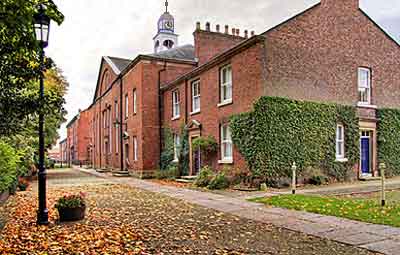
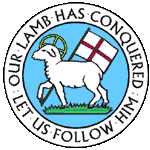
Fairfield Moravian Church and its surrounding Moravian Settlement was founded in 1785 by the Revd Benjamin La Trobe (1725-1786) as a centre for the evangelistic work of the Moravian Church in the Manchester area. The self-contained village is of exceptional national importance, being the earliest and largest of its kind in Britain. It was designed around a square with the church on the south side overlooking an avenue of trees, gardens and a graveyard. It is now a Tameside Conservation Area with all of its buildings being of special historic and architectural interest. The church with its contiguous manse and house is listed Grade II*, List Entry No. 1067981.
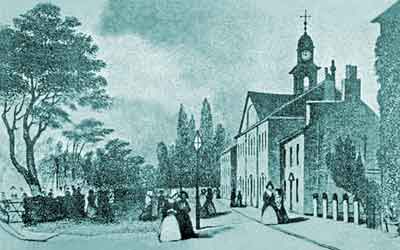

The Moravian Church & Jan Hus (c.1369-1415)
The origin of the branch of the Christian Church known as the Moravian Church, or Unitas Fratrum (Unity of the Brethren), was at Kunvald, Bohemia, in the year 1457 by followers of Jan Hus.
The regions of Bohemia, Moravia and Silesia were part of the Lands of the Bohemian Crown, now the Czech Republic.
Initially known as the Hussite movement, its origins trace back Jan Hus in Bohemia and this became known as the Moravian Church.
From this beginning it spread across Europe and the New world. The first settlement in Britain was the Fulneck Moravian Settlement at Pudsey, Yorkshire, which dates back to 1744.

Jan Hus.
Revd Benjamin La Trobe (1725-1786) & his son Benjamin Henry La Trobe (1764-1820)
The Revd Benjamin La Trobe was of Huguenot (French Protestant) ancestry and he was born in Dublin on the 19 Apr 1725 and educated at the University of Glasgow.
He entered the ministry of the Moravian Church where he became a leading minister. He married Anna Margaretta Antes in Herrnhut, eastern Saxony, Germany, in 1756.
He died at the Teston Vicarage, near Maidstone, Kent, on the 29 Nov 1786 and he is buried in the Moravian Burial Ground in the Royal Borough of Kensington and Chelsea, London.
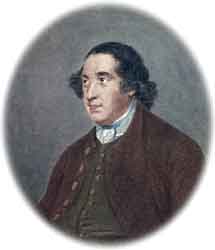
Revd Benjamin La Trobe.
His son, Benjamin Henry La Trobe (or Latrobe), became an eminent neoclassical architect in the USA. He is especially noted for his design of the United States Capitol, the White House porticos and Baltimore Basilica.
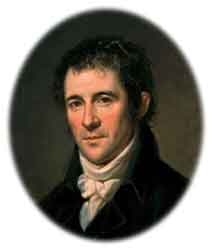
Benjamin Henry La Trobe.
Charles Hindley MP (1796-1857)
Charles Hindley was born into a cotton-mill owning family and like his parents he was a member of the Moravian Church and remained so throughout his life.
A commemorative blue plaque is fixed to his former home in the Fairfield Moravian Settlement on the north side of Fairfield Square, opposite Sister St.
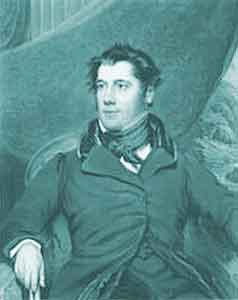
He also laid the foundation stone of the evangelical free Westminster Chapel in London on the 3 Aug 1840, which is situated in Buckingham Gate on the corner of Castle Ln. In 1855 he presented a silver loving cup to the Corporation of Ashton-under-Lyne for use at social meetings of the Corporation.
Like his father, Ignatius Hindley, he was a cotton-mill owner but he also became a politician who was the Radical Member of Parliament for Ashton-under-Lyne from 1835 until his death in 1857. He was active in the movement for factory reform and above all for the reduction of the length of the working day. He also opposed the New Poor Law and state involvement in religious and educational matters. He was prominent in the Peace Society and in the International Peace Congress Movement. He specifically discussed these issues with the Revd Joseph Rayner Stephens of Ashton-under-Lyne and Stalybridge. He was, however, inclined to moderation and compromise with these issues.
Statue of a Moravian lady and boy
This statue was unveiled on the 18 Sep 2009 and it is situated by the entrance to the settlement off the south side of Fairfield Rd.
The sculptor was Peter Walker and it was made by Castle Fine Art.
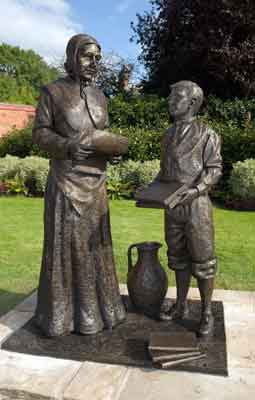
Jan Amos Komensky (John Amos Cornelius) (1592–1670)
He was a theologian who was the last bishop of the Unity of the Brethren, the direct predecessor of the Moravian Church.
Moreover, he was also a renowned pedagogue and philosopher, widely considered to be the father of modern education.
He pioneered the concept of universal education and is celebrated in the Czech Republic, where his birthday (28 March) is observed as Teachers' Day.

Jan Amos Komensky.